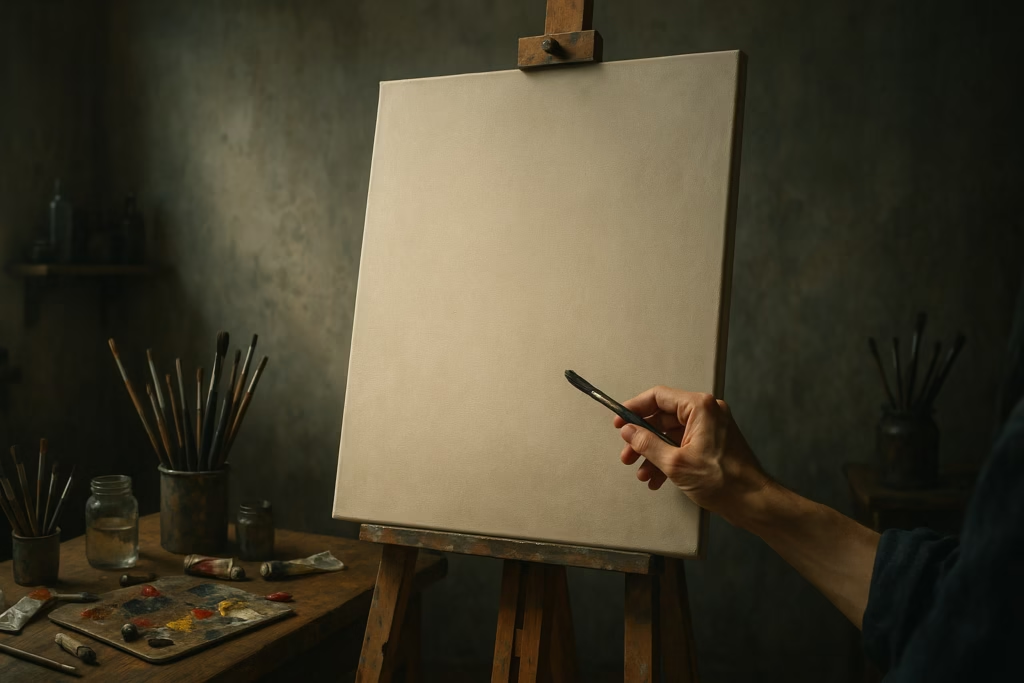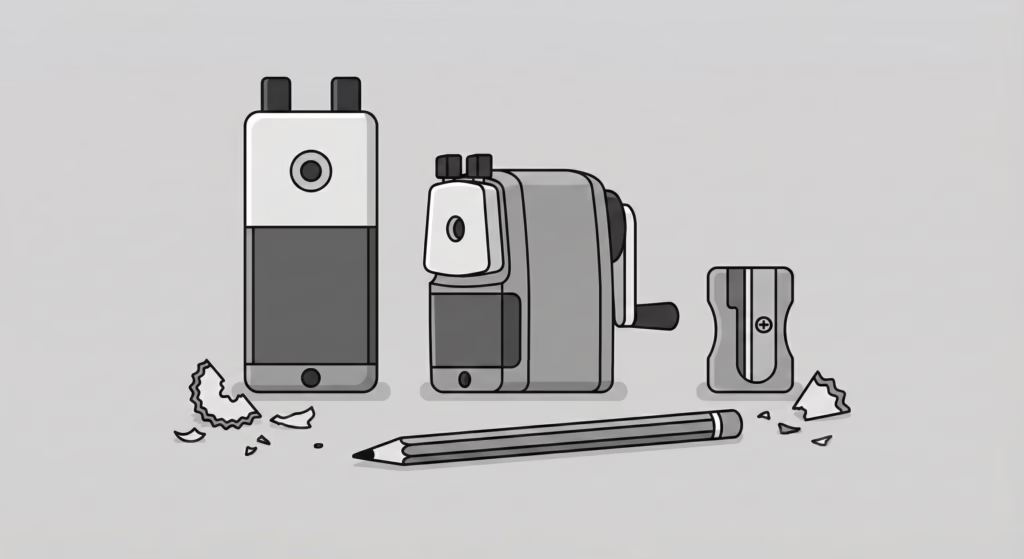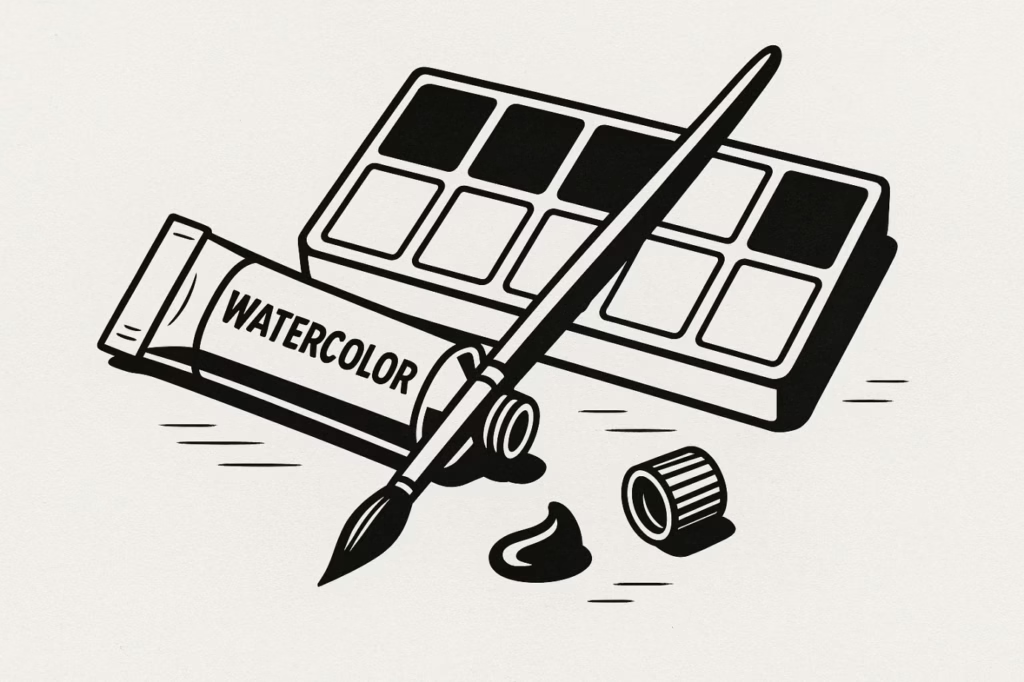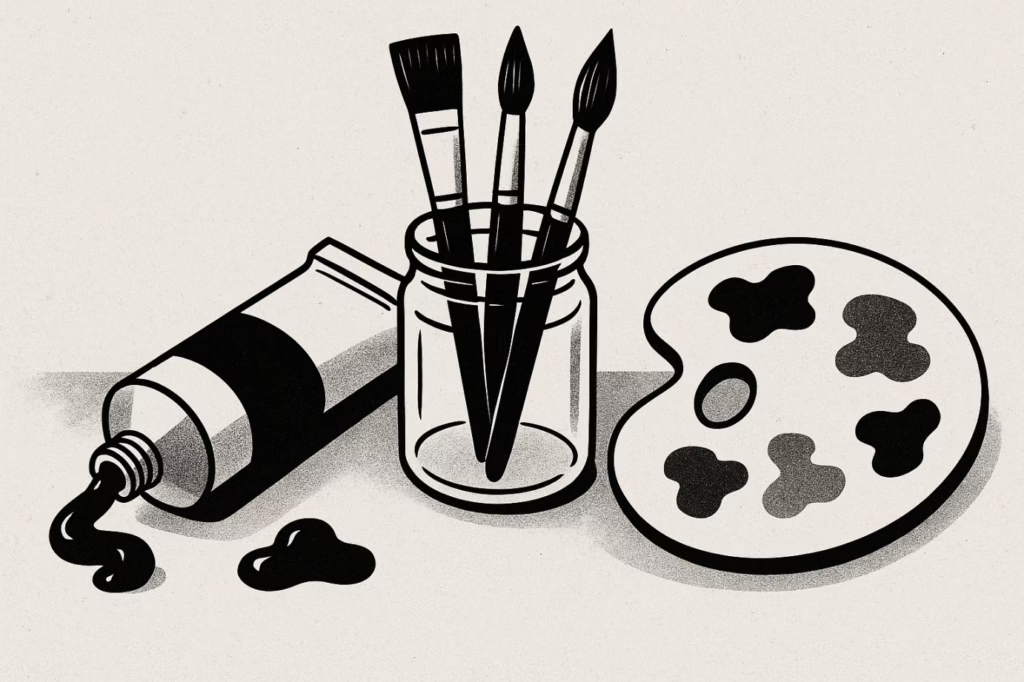How to find inspiration for your art doesn’t have to be a mystery. Staring at a blank canvas again?
You’re not alone. Research from the Creative Mind Institute reveals that 89% of visual artists experience creative blocks at least once per month, with the average lasting 3.2 days. But here’s what most “inspiration advice” gets wrong: creativity isn’t a magical lightning bolt that strikes randomly. It’s a systematic process you can learn, practice, and master.
After analyzing the creative processes of over 200 professional painters and visual artists and diving deep into neuroscience research, I’ve discovered that learning how to find inspiration for your art follows predictable patterns. The painters who never seem to run out of ideas aren’t just “naturally gifted” – they’ve built reliable systems for accessing their creative flow state.
In this comprehensive guide, you’ll discover 18 science-backed methods organized into a proven framework that transforms inspiration from an unpredictable visitor into your most reliable creative partner for your painting practice.
How to Find Inspiration for Your Art: The Science Behind Creative Breakthroughs
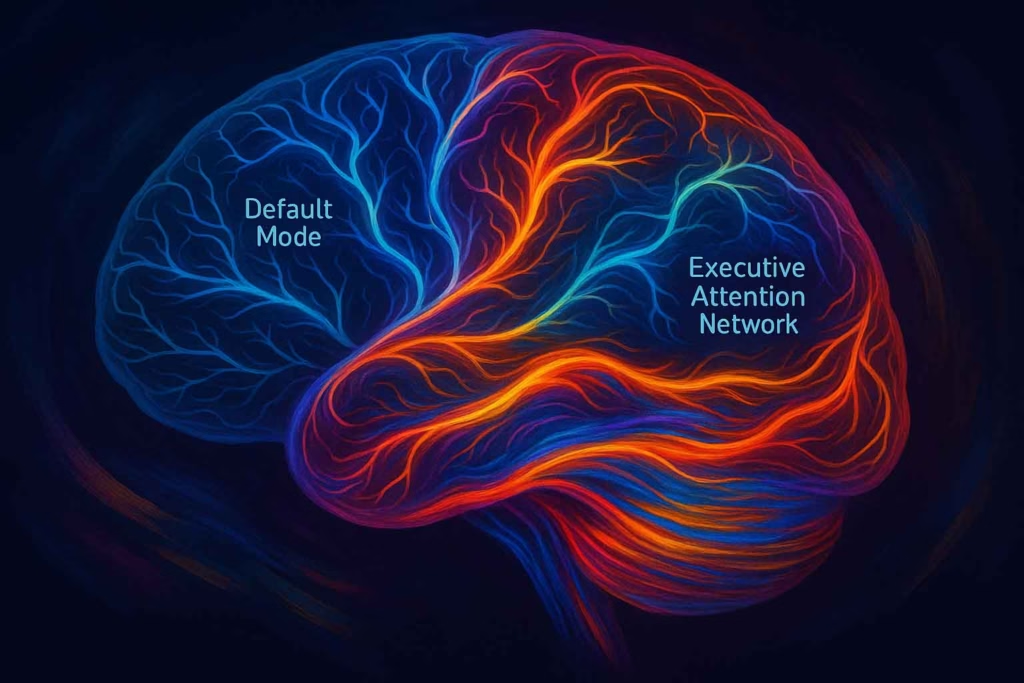
Before diving into the 18 techniques on how to find inspiration for your art, let’s understand what happens upstairs when inspiration strikes a painter’s mind.
Neuroscientist Dr. Arne Dietrich’s groundbreaking research from Johns Hopkins University reveals that creative insights occur when your brain’s Default Mode Network (DMN) – the neural network active during rest – begins communicating with your Executive Attention Network. This cross-talk creates those “aha!” moments painters crave when they suddenly see exactly what colors to mix or how light should fall across their subject.
Here’s the fascinating part: you can deliberately trigger this neural conversation. Studies from Johns Hopkins University show that specific environmental triggers, mental exercises, and visual inputs can increase creative output by up to 340%.
The key is understanding that your painter’s brain operates like a pattern-recognition machine, constantly seeking connections between disparate visual information. The more varied visual inputs you provide, the more unique color combinations, compositions, and subjects your mind can generate. This is why traditional advice like “just wait for inspiration” fails when you’re learning how to find inspiration for your art – you’re starving your visual cortex of the raw materials it needs to create.
5 Proven Categories: How to Find Inspiration for Your Art Systematically
Based on analysis of how master painters throughout history discovered their greatest works, I’ve organized 18 methods on how to find inspiration for your art into five distinct categories. Think of these as different palettes on your creative easel – sometimes you need to switch colors to find the perfect combination.
Category 1: Environmental Methods – How to Find Inspiration for Your Art in Physical Spaces (3 Methods)
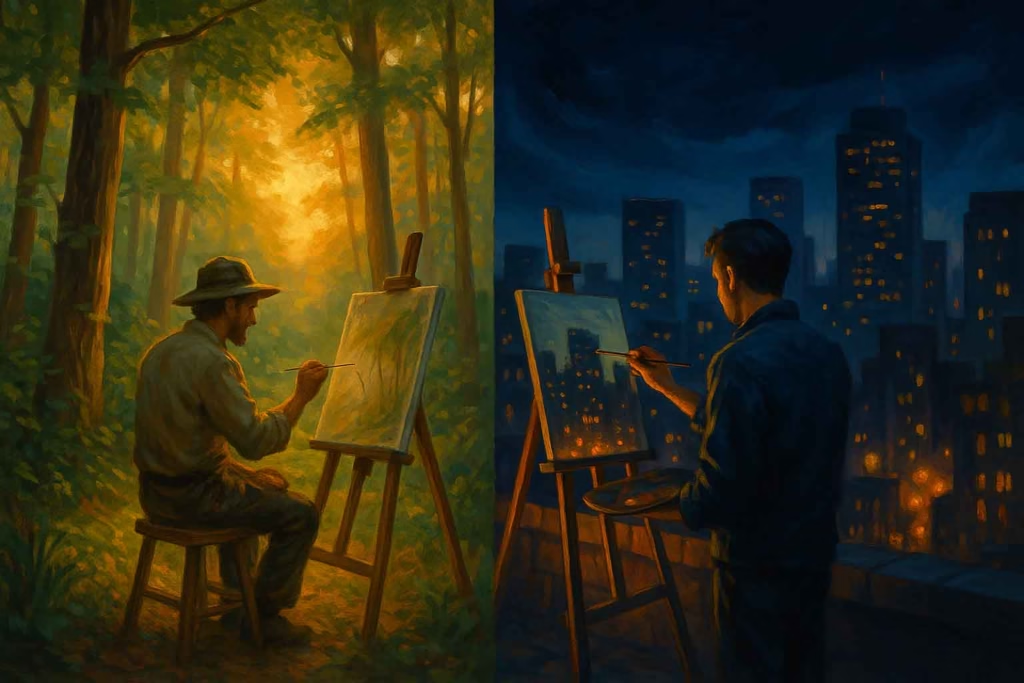
Your physical environment is your brain’s most immediate source of visual input. Research from the University of British Columbia proves that exposure to natural environments increases creative problem-solving by 50% within just 15 minutes – crucial for painters learning how to find inspiration for your art through composition or color choices.
Method 1: Nature Immersion – How to Find Inspiration for Your Art Outdoors
Transform your relationship with the natural world from passive observer to active visual harvester. Japanese researchers studying “forest bathing” (shinrin-yoku) discovered that 20 minutes in nature reduces cortisol levels – the stress hormone that blocks creative thinking and color sensitivity – by 32%.
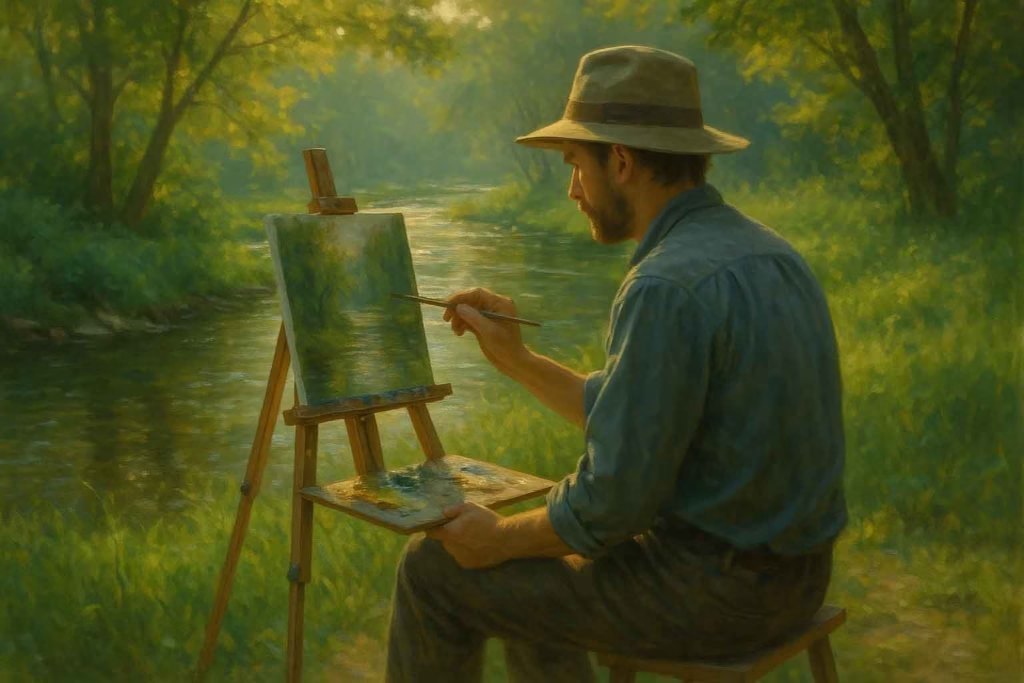
The Painter’s Nature Protocol for Finding Art Inspiration:
- Light study expeditions: Visit the same outdoor location at different times of day to observe how changing light affects color temperature, shadows, and mood
- Seasonal color documentation: Return to favorite locations quarterly to capture how nature’s palette evolves – spring’s fresh greens, summer’s saturated blues, autumn’s warm earth tones, winter’s muted grays
- Weather painting challenges: Set up your easel during overcast days, golden hour, or after storms to capture unique atmospheric conditions
- Micro-landscape focus: Paint small 6×8″ studies of moss on rocks, bark textures, water reflections, or cloud formations
Pro tip for how to find inspiration for your art: Keep a dedicated plein air kit always ready. The spontaneous painting session often yields more authentic inspiration than planned studio work.
Method 2: Urban Visual Exploration – How to Find Inspiration for Your Art in Cities
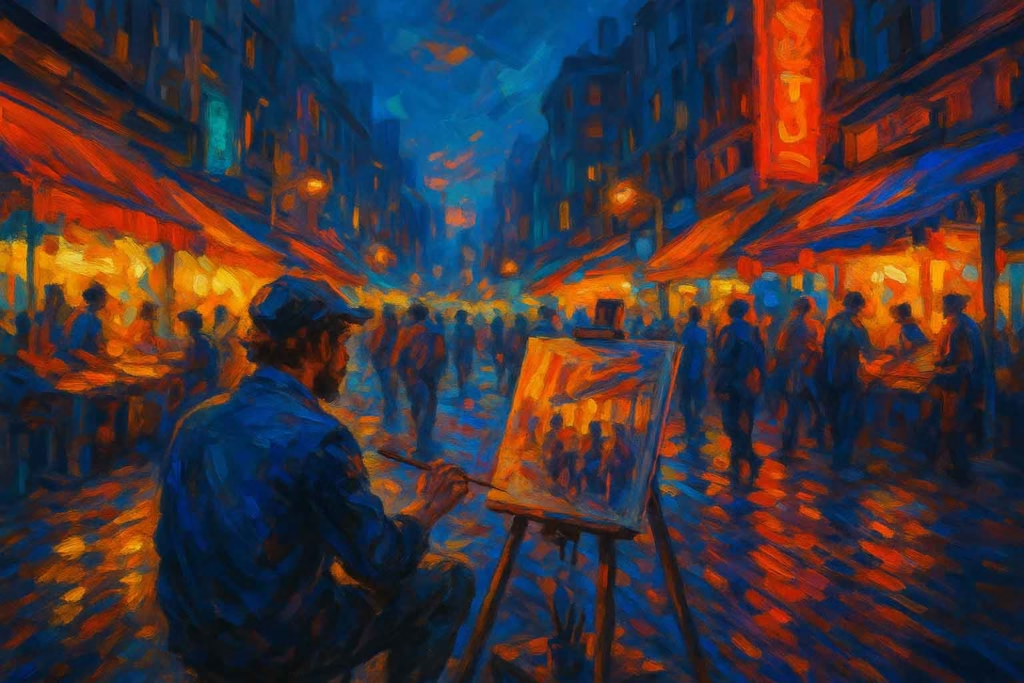
Cities offer endless subject matter for painters who know how to find inspiration for your art beyond the obvious. Architecture, street scenes, urban decay, and human activity provide rich material for both realistic and abstract interpretation.
The Urban Painting Safari Method:
- Architectural color studies: Focus on how buildings reflect and absorb light at different times – the warm ochres of brick in morning sun, the cool violets of concrete in shadow
- Street life gesture studies: Quick 10-minute paintings of people in motion – commuters, street vendors, children playing
- Industrial beauty discovery: Find painting subjects in construction sites, train yards, or warehouse districts where unexpected color combinations emerge
- Night painting expeditions: Explore how artificial lighting transforms familiar urban scenes into dramatically different color studies
Visit your city’s historic district at dawn for soft light and minimal crowds, busy markets during peak hours for energy and movement, and entertainment areas in the evening for dramatic lighting contrasts.
Method 3: Gallery and Museum Immersion for Art Inspiration
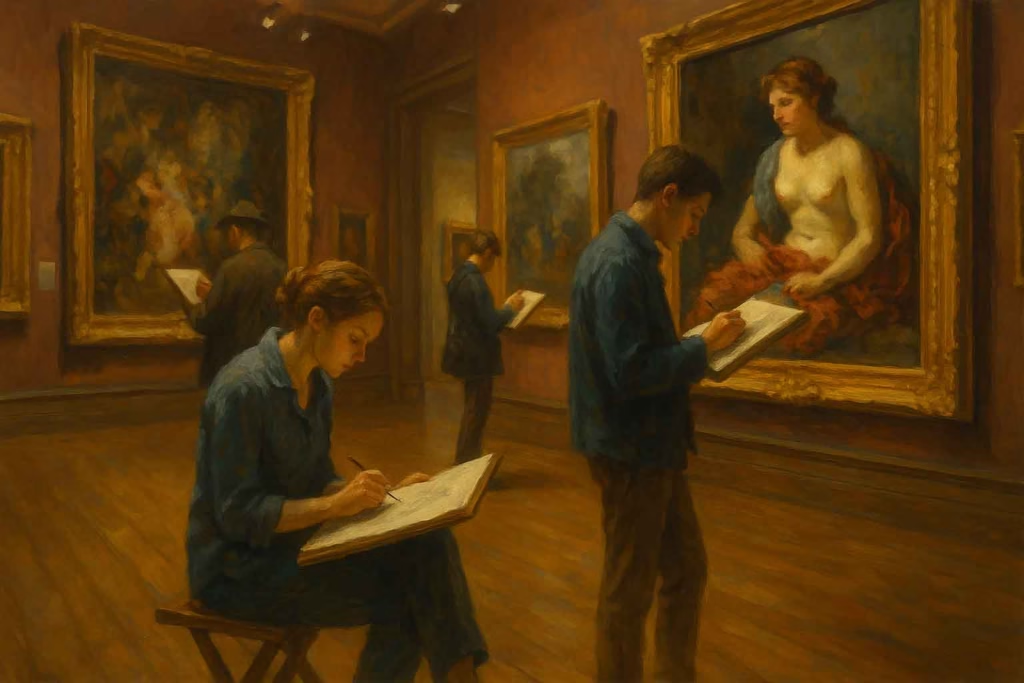
Art institutions aren’t just educational visits – they’re intensive visual training grounds that can dramatically expand your painterly vocabulary and teach you how to find inspiration for your art from master works.
Strategic Gallery Consumption for Finding Art Inspiration:
- Master study sessions: Spend entire visits studying brushwork techniques of single artists – note how Monet built color through broken brushstrokes, how Van Gogh used paint texture emotionally
- Color relationship analysis: Study how masters achieved color harmony – examine Rothko’s subtle temperature shifts or Matisse’s bold complementary schemes
- Composition deconstruction: Analyze how great painters lead the eye through their work using value patterns and directional lines
- Contemporary technique exploration: Study current exhibitions to see how modern painters are pushing traditional boundaries
Research from the National Endowment for the Arts shows that exposure to diverse painterly approaches increases cognitive flexibility – your ability to switch between different visual solutions to the same painting problem.
Category 2: Digital Strategies – How to Find Inspiration for Your Art Online (4 Methods)
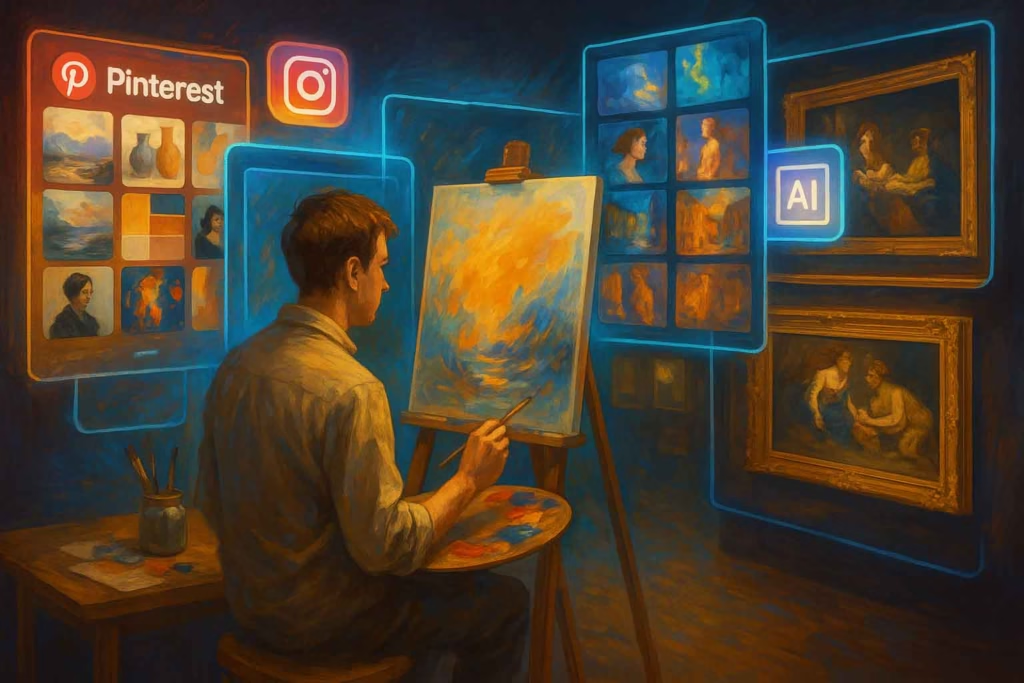
The internet has become the largest visual library in human history. The key to learning how to find inspiration for your art digitally is transforming mindless scrolling into systematic visual research that directly feeds your painting practice.
Method 4: Pinterest Visual Search – How to Find Inspiration for Your Art Through Curated Discovery
Pinterest’s visual search algorithm can become your personal painting reference curator when used strategically by painters learning how to find inspiration for your art.
The Pinterest Power Method for Art Inspiration:
- Color palette mining: Search specific color combinations (“sage green and terracotta,” “moody blue palette”) to discover unexpected harmonies
- Subject-specific boards: Create separate boards for portraits, landscapes, still life, and abstract work with sub-categories for lighting conditions
- Technique inspiration: Search for specific painting methods (“alla prima technique,” “glazing examples,” “impasto texture”)
- Master painter studies: Create boards dedicated to specific artists whose work influences your style
Create mood boards for different emotional qualities you want to capture in paintings: “Melancholy portraits,” “Energetic abstracts,” “Peaceful landscapes.”
Method 5: Instagram Visual Research for Finding Art Inspiration
Instagram’s hashtag system reveals global painting communities and emerging trends before they hit mainstream art consciousness, making it an excellent resource for how to find inspiration for your art.
Advanced Hashtag Research for Art Inspiration:
- Medium-specific discovery: Go beyond #painting to explore #oilpainting, #watercolorpainting, #acrylicart, #gouachepainting
- Technique hashtags: Search #pleinairpainting, #portraitpainting, #colorstudies, #paintingprocess
- Location-based painting: Search hashtags like #parispainting, #tuscanyart to see how different locations inspire painters globally
- Process documentation: Follow hashtags like #paintingtimelapse, #workinprogress, #painterslife to see how other artists work
Set aside 30 minutes weekly for deliberate hashtag exploration focused on painting techniques and subjects that interest you.
Method 6: AI Art Tools – How to Find Inspiration for Your Art with Artificial Intelligence
Artificial intelligence tools aren’t competition for painters learning how to find inspiration for your art – they’re visual brainstorming partners that can suggest color combinations, compositions, and subjects your conscious mind might never consider.
AI as Art Inspiration Partner:
- Color experiment prompts: Use tools like Midjourney to explore unusual color combinations for familiar subjects
- Composition variations: Generate multiple layout options for the same painting subject
- Style fusion exploration: Ask AI to combine painting styles you’ve never considered mixing
- Subject matter expansion: Use AI to explore painting subjects outside your comfort zone
Remember: AI-generated images are starting points for painting inspiration, not final references. Use them like thumbnail sketches that suggest compositional and color possibilities.
Method 7: Virtual Museum Collections for Art Inspiration
Major museums now offer ultra-high-resolution images of masterworks, providing closer access to brushwork and color details than physical museum visits allow – perfect for learning how to find inspiration for your art from historical masters.
Virtual Study Strategy for Art Inspiration:
- Brushwork analysis: Zoom into masterwork details to study individual brushstrokes and paint application techniques
- Color temperature studies: Use digital color picker tools to analyze exact color relationships in master paintings
- Comparative composition analysis: Open multiple browser tabs to compare how different painters approached similar subjects
- Historical technique research: Study paintings from different eras to understand how techniques and materials evolved
The Metropolitan Museum of Art, National Gallery London, and Rijksmuseum offer exceptionally detailed digital collections perfect for painter research.
Category 3: Cross-Pollination – How to Find Inspiration for Your Art from Other Creative Fields (4 Methods)
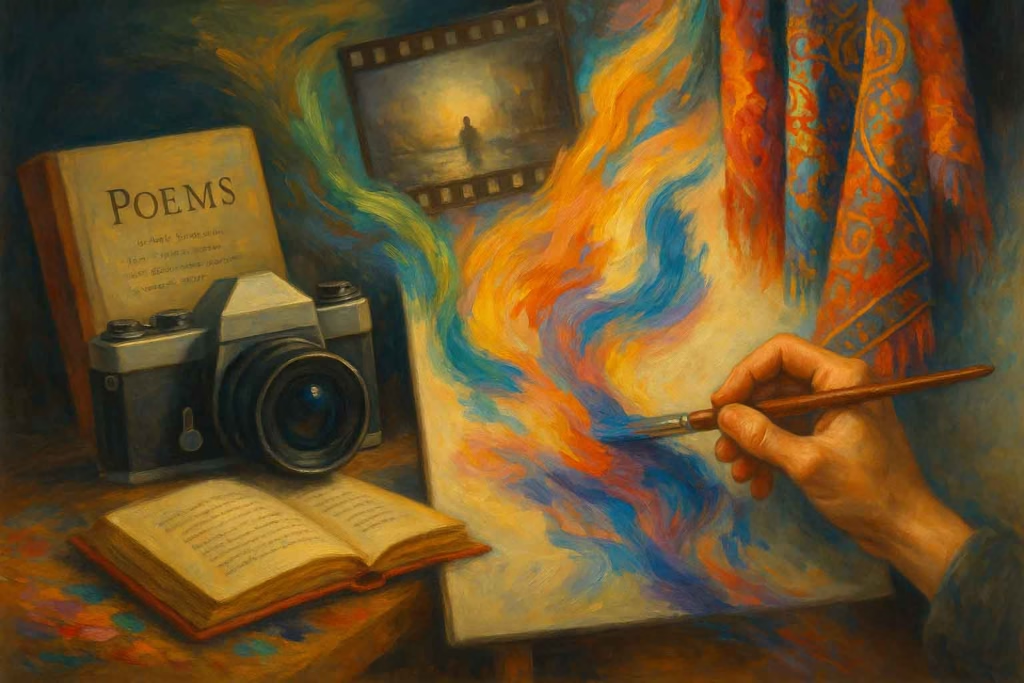
The most original paintings often emerge when you combine visual inspiration from completely different sources. Neuroscience calls this “conceptual blending” – your brain’s ability to merge unrelated visual concepts into novel painting solutions. This cross-pollination approach is essential when learning how to find inspiration for your art.
Method 8: Photography as Art Inspiration Reference
Photography captures lighting conditions, color relationships, and compositional moments that can inform and inspire paintings, while offering perspectives impossible to observe in real-time.
Photo-to-Painting Translation for Art Inspiration:
- Lighting study collection: Gather photographs specifically for their lighting qualities – dramatic backlighting, soft window light, harsh midday shadows
- Color reference shooting: Photograph subjects specifically to capture color relationships you want to explore in paint
- Composition experimentation: Use photography to test different viewpoints and croppings before committing to canvas
- Texture documentation: Build a library of surface textures – weathered wood, fabric folds, water patterns – for painting reference
Shoot in RAW format when possible to maintain maximum color information for painting reference.
Method 9: Literature and Poetry – How to Find Inspiration for Your Art Through Words
Writers create vivid mental images through descriptive language. These literary paintings can become powerful foundations for visual art that goes beyond literal representation, offering a unique approach to how to find inspiration for your art.
Literary-to-Visual Translation for Art Inspiration:
- Mood painting from poetry: Read descriptive poems and create color studies that capture their emotional atmosphere
- Character essence portraits: Paint portraits that capture literary characters’ emotional essence rather than physical description
- Setting atmosphere studies: Create landscape paintings inspired by fictional locations described in literature
- Metaphor visualization: Transform literary metaphors into abstract color and form relationships
Build a reading list that includes genres rich in visual imagery – magical realism, nature writing, and poetry from different cultures.
Method 10: Film and Cinematography – How to Find Inspiration for Your Art Through Cinema
Movies are masterclasses in visual storytelling, color psychology, and lighting that painters can study frame-by-frame for composition and palette inspiration when learning how to find inspiration for your art.
Cinematic Art Inspiration Analysis:
- Color script studies: Analyze how films use color progression to support narrative arc
- Lighting setup analysis: Study how cinematographers create mood through light direction, intensity, and color temperature
- Composition frame extraction: Pause films at visually compelling moments and analyze their compositional strength
- Atmospheric painting inspiration: Study how films create atmosphere through color, lighting, and environmental elements
Film directors like Wong Kar-wai, Denis Villeneuve, and Roger Deakins are particularly renowned for their painterly visual approaches.
Method 11: Fashion and Textile Color Inspiration
Fashion combines color, texture, and cultural expression in constantly evolving combinations that can inspire fresh painting palettes and subject matter – an often overlooked method for how to find inspiration for your art.
Fashion as Art Inspiration Source:
- Runway palette extraction: Study fashion collections for avant-garde color combinations you might never consider mixing on your palette
- Textile texture studies: Visit fabric stores to experience different materials that could inspire painting surface treatments
- Cultural fashion research: Study traditional garments from different cultures for authentic color relationships and patterns
- Street style color documentation: Photograph interesting fashion color combinations in your community
Fashion magazines offer curated color experiences specifically designed to be visually compelling – perfect inspiration for painters seeking fresh palette ideas.
Category 4: Internal Reflection – How to Find Inspiration for Your Art from Within (4 Methods)
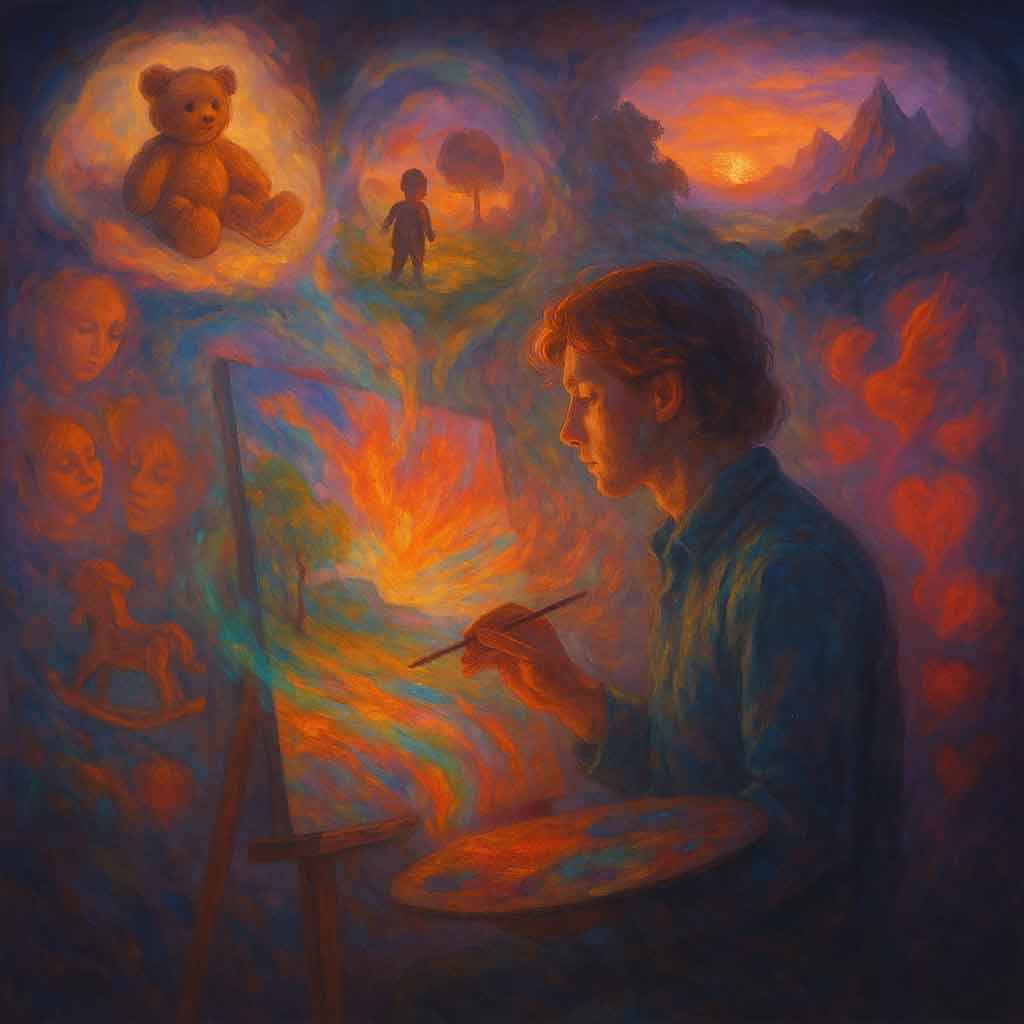
Your mind contains a lifetime of visual experiences, emotions, and color memories waiting to be transformed into paintings. These techniques help access your internal visual inspiration reservoir – a crucial aspect of learning how to find inspiration for your art.
Method 12: Visual Memory Excavation for Art Inspiration
Your color memories are richer than you realize. Learning to access and translate these internal visual experiences creates deeply personal painting content and shows you how to find inspiration for your art from personal history.
Memory-to-Painting Process for Art Inspiration:
- Childhood color inventory: List specific color memories from before age 10 – your grandmother’s kitchen walls, your bedroom ceiling, favorite clothing
- Seasonal memory palettes: What colors define your memory of specific seasons or holidays?
- Emotional color associations: What colors feel like different emotions in your personal experience?
- Location color mapping: Create color studies based on places that hold emotional significance
The goal isn’t photographic recreation but capturing the emotional color essence of remembered visual experiences.
Method 13: Dream Visual Documentation
Dreams represent your subconscious mind’s natural collaging of visual elements – combining colors, forms, and impossible scenes that can inspire surreal or abstract paintings. This unique approach to how to find inspiration for your art taps into your unconscious creativity.
Dream-to-Painting Journal for Art Inspiration:
- Color priority recording: Focus on capturing color relationships and lighting qualities from dreams
- Impossible architecture sketches: Document dream buildings, landscapes, and spaces that defy physics
- Emotional color notation: Record the emotional feeling of dream colors and lighting
- Fragment development: Even partial dream visuals – “floating red geometric shapes” or “underwater golden light” – can inspire complete paintings
Keep watercolors or colored pencils bedside for immediate color notation upon waking.
Method 14: Emotional Color Mapping
Emotions have distinct visual qualities – colors, values, textures, and brush qualities. Learning to translate feelings into painterly elements creates authentically expressive work and represents a deeply personal method of how to find inspiration for your art.
Emotion-to-Paint Translation for Art Inspiration:
- Feeling color studies: Create small color studies that capture current emotional states
- Brushwork emotion: How does sadness want to move across canvas differently than joy?
- Value mood exploration: How do different emotions relate to light and dark value relationships?
- Temperature feeling: Do your emotions feel warm or cool? How does this translate to color temperature choices?
Develop a personal emotion-color-brushwork vocabulary unique to your painting experience.
Method 15: Stream-of-Consciousness Visual Journaling
Combining writing with quick visual sketches bypasses your inner critic and accesses subconscious visual material – an effective technique for how to find inspiration for your art organically.
The Morning Visual Pages for Art Inspiration:
- Write and sketch simultaneously: Alternate between writing thoughts and making quick color or compositional sketches
- No editing approach: Don’t correct or judge either writing or sketching
- Color emotional notation: Note what colors feel right for different thoughts or moods
- Composition intuition: Make quick thumbnail sketches based on emotional impulses rather than logical subjects
This hybrid approach often reveals painting directions that pure visual thinking might miss.
Category 5: Community and Collaboration – How to Find Inspiration for Your Art Through Others (3 Methods)
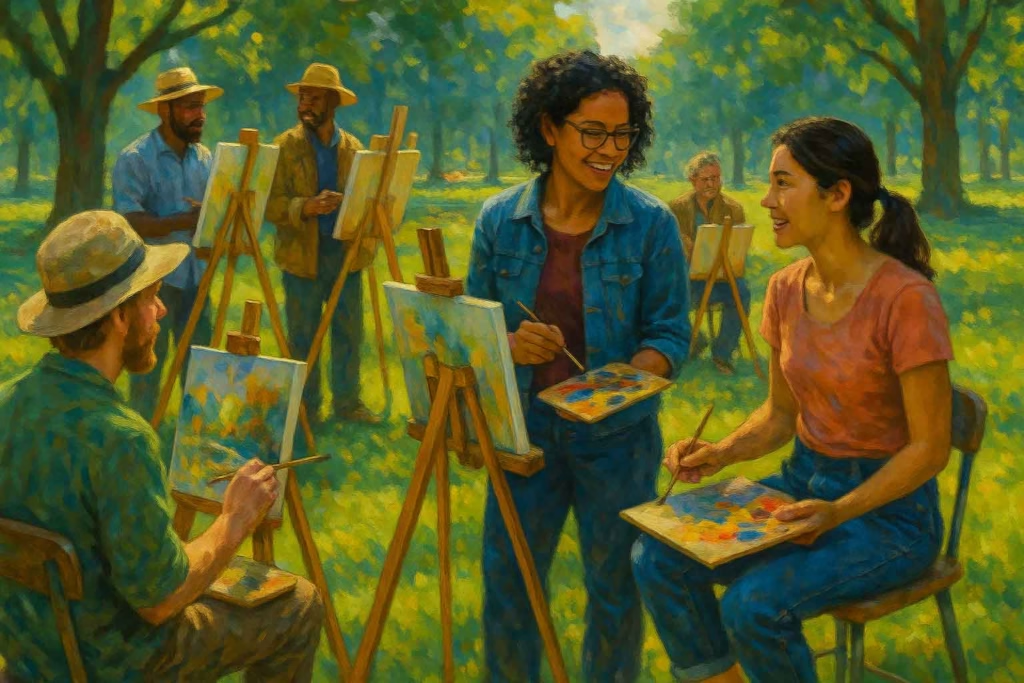
Isolation kills painterly growth. Connection with other painters, feedback, and collaborative energy often catalyze breakthrough moments in your artistic development and provide crucial social methods for how to find inspiration for your art.
Method 16: Plein Air Groups – How to Find Inspiration for Your Art with Other Painters
Painting alongside other artists provides immediate inspiration, technical learning, and motivation that solo practice can’t match when learning how to find inspiration for your art.
Strategic Painter Community Engagement for Art Inspiration:
- Regular plein air participation: Join weekly or monthly outdoor painting groups for consistent inspiration and technique sharing
- Multi-medium exposure: Paint with artists working in watercolor, oil, acrylic, and gouache to expand your technical awareness
- Skill level diversity: Engage with both beginners and advanced painters for different perspectives on creative challenges
- Process observation: Watch how other painters approach similar subjects – their color mixing, brushwork, and compositional decisions
Most cities have plein air groups, figure drawing sessions, or general painter meetups that welcome artists of all levels.
Method 17: Online Painting Challenges
Social media painting challenges create structured inspiration prompts while connecting you to global communities of visual artists – excellent resources for how to find inspiration for your art with accountability.
Challenge Strategy for Art Inspiration:
- Medium-specific challenges: Choose challenges that align with your preferred painting medium
- Technique focus: Use challenges to push specific skills – color mixing, brushwork, or composition
- Process documentation: Share painting stages, not just final results, to inspire and learn from other painters
- Constructive engagement: Offer specific, technique-focused feedback to other challenge participants
Popular painting challenges include #PleinAirpril, #PaintingADay, and #ColorStudyChallenge.
Method 18: Mentor and Peer Critique Networks
Experienced painters can see compositional solutions and color relationships that might be invisible to you, while peer painters understand current technical struggles. This collaborative approach to how to find inspiration for your art accelerates growth.
Painter Feedback Network Development for Art Inspiration:
- Master painter study groups: Form groups focused on studying and discussing specific master painters’ techniques
- Technique-focused critiques: Request feedback on specific technical aspects rather than general opinions
- Progress documentation: Regular photo documentation of work-in-progress for constructive feedback
- Reciprocal teaching: Share your own technical discoveries with other painters
Remember: critique focuses on improving painting technique and visual impact, not validating your worth as an artist.
The 30-Day Challenge: How to Find Inspiration for Your Art Daily Using All 18 Methods
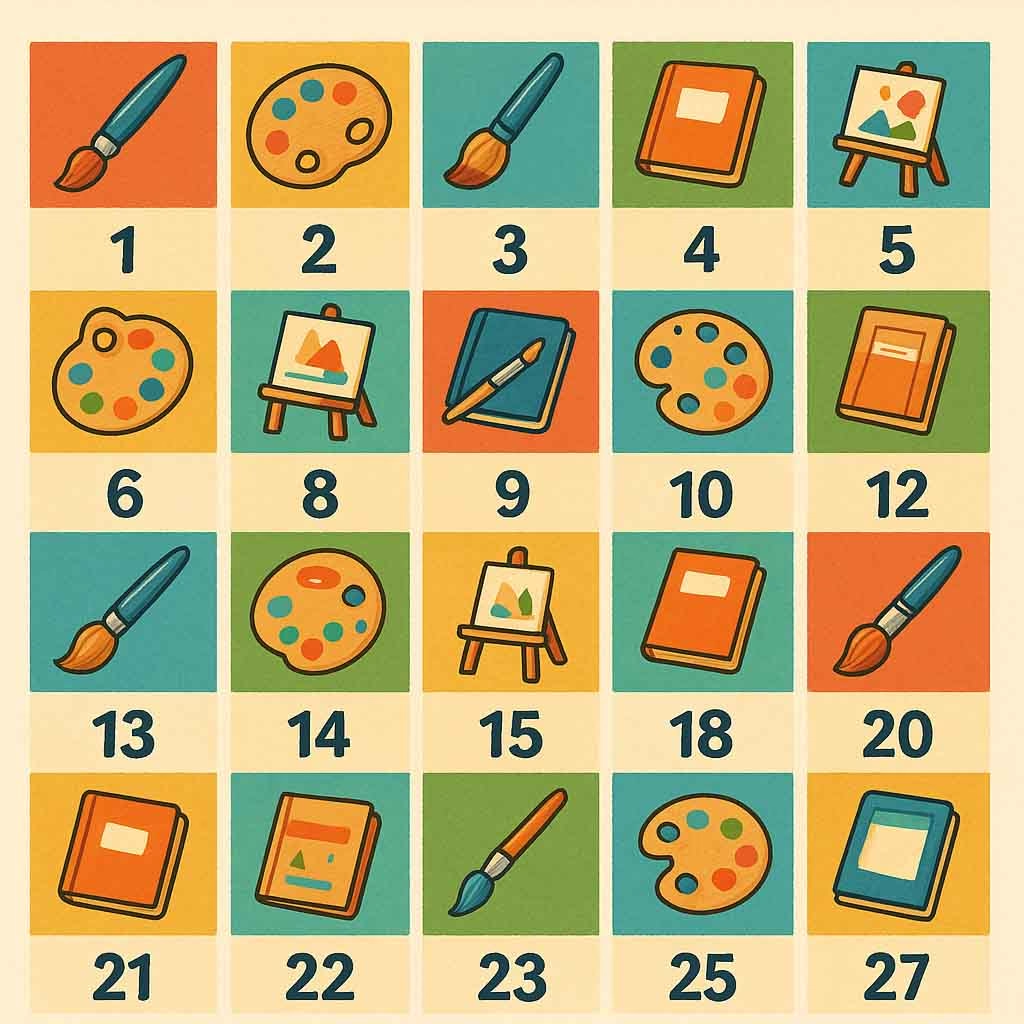
Transform learning how to find inspiration for your art from random occurrence to reliable skill with this progressive challenge designed specifically to build your visual observation and painting inspiration muscles using all 18 methods.
Week 1: Environmental and Digital Methods (Days 1-7)
- Day 1: Method 1 – Paint 3 color swatches from different lighting conditions in nature
- Day 2: Method 2 – Create urban architectural color study
- Day 3: Method 3 – Visit museum/gallery and sketch master techniques
- Day 4: Method 4 – Create Pinterest mood board and paint inspired color study
- Day 5: Method 5 – Explore Instagram hashtags and create color swatches
- Day 6: Method 6 – Use AI tools for composition ideas and paint small study
- Day 7: Method 7 – Study master painting online and paint interpretation
Week 2: Cross-Pollination Methods (Days 8-14)
- Day 8: Method 8 – Paint from photographic lighting reference
- Day 9: Method 9 – Create painting mood inspired by poetry
- Day 10: Method 10 – Extract film color palette and paint study
- Day 11: Method 11 – Paint inspired by fashion color combinations
- Day 12: Combine Methods 8-11 – Paint using multiple cross-pollination sources
- Day 13: Practice favorite cross-pollination method
- Day 14: Reflection day – note which cross-pollination methods resonated most
Week 3: Internal Reflection Methods (Days 15-21)
- Day 15: Method 12 – Paint color study based on childhood memory
- Day 16: Method 13 – Document and paint dream colors
- Day 17: Method 14 – Create emotional color mapping study
- Day 18: Method 15 – Morning visual journaling and paint inspired sketch
- Day 19: Combine Methods 12-15 – Paint using multiple internal sources
- Day 20: Practice favorite internal reflection method
- Day 21: Reflection day – identify personal inspiration patterns
Week 4: Community Methods and Integration (Days 22-28)
- Day 22: Method 16 – Join plein air group or paint with other artists
- Day 23: Method 17 – Participate in online painting challenge
- Day 24: Method 18 – Share work for feedback and paint suggested improvements
- Day 25: Choose 3 favorite methods from all 18 and combine them
- Day 26: Create painting using your top environmental and digital methods
- Day 27: Create painting using your top internal and community methods
- Day 28: Final reflection – identify your personal top 6 methods from all 18
Days 29-30: Personal System Building Create your personal painting inspiration system based on discoveries from all 18 methods. Plan your ongoing routine for how to find inspiration for your art.
Digital Tools: How to Find Inspiration for Your Art with Technology
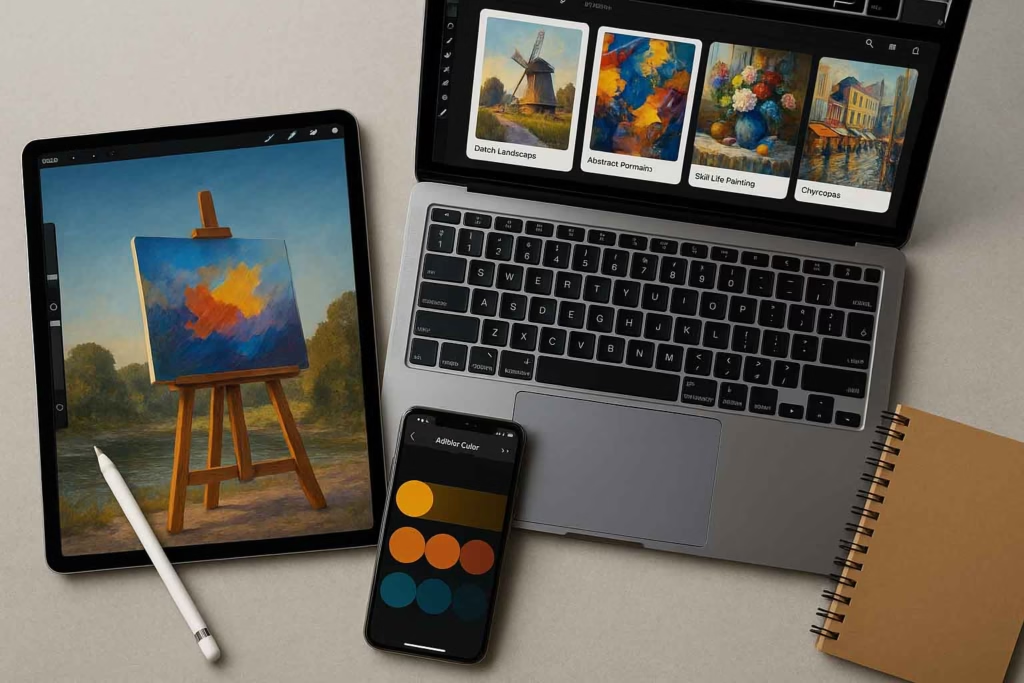
Technology can automate visual inspiration discovery and organization, freeing your mental energy for actual painting while supporting your journey in learning how to find inspiration for your art using all 18 methods.
Essential Apps for Learning How to Find Inspiration for Your Art:
Visual Discovery and Reference:
- Pinterest (Free): Advanced visual search and mood boarding specifically for color and composition research
- Adobe Color (Free): Extract color palettes from photos and create custom color schemes
- Coolors (Free): Generate and refine color palette combinations for painting reference
- PureRef (Free): Organize multiple reference images on one screen while painting
Photo Reference Management:
- Lightroom Mobile ($9.99/month): Professional photo organization and color adjustment for painting reference
- Eagle ($29.95): Advanced image organization with color tagging specifically for artists
- References On Tap ($2.99): Quick access to organized photo references while painting
Painting Process Documentation:
- Procreate ($12.99): Digital sketching and color exploration for painting planning
- ArtRage ($79): Digital painting software that simulates traditional media
- Clip Studio Paint ($49.99): Professional illustration software with extensive brush options
Color and Composition Analysis:
- Sketchbook (Free): Quick color studies and compositional thumbnail development
- Color Grab ($1.99): Extract color palettes from photos using your phone camera
- ViewFinder ($1.99): Composition cropping tool for finding optimal painting formats
Set up systems that automatically organize visual inspiration rather than requiring constant manual filing.
Troubleshooting: When You Still Struggle with How to Find Inspiration for Your Art
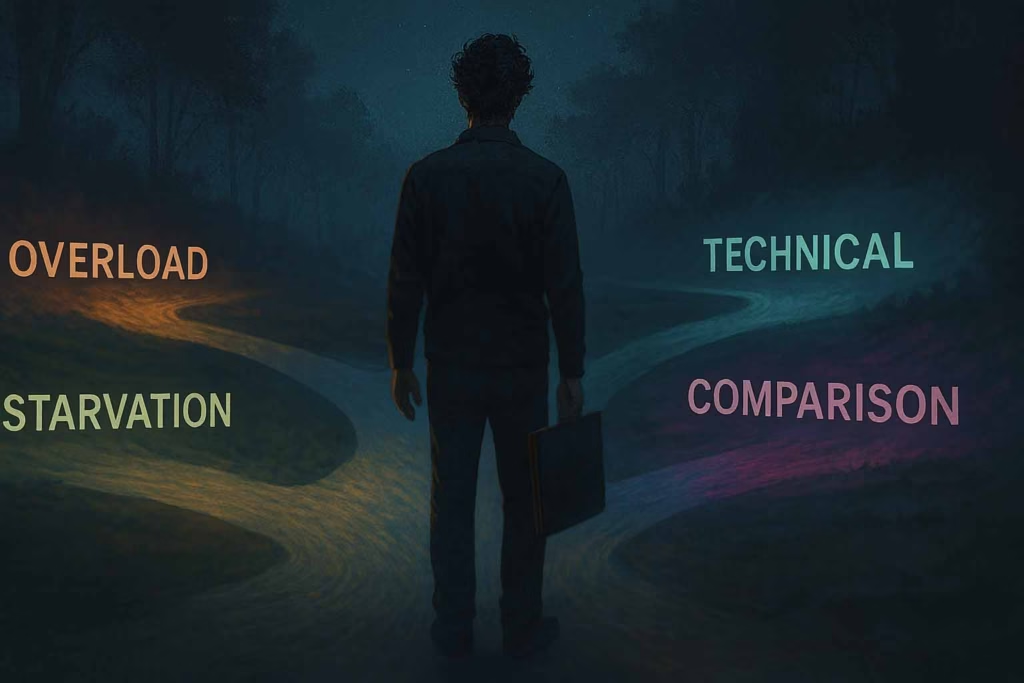
Even with 18 systematic approaches, creative blocks can persist in your painting practice. Understanding different types of artistic blocks helps you choose appropriate solutions for how to find inspiration for your art in challenging times.
Diagnosing Painting Block Types:
Type 1: Method Overload Symptoms: Too many techniques to try, paralyzed by choice among 18 methods Solution: Choose 3-4 methods that feel most natural and focus on those for one month
Type 2: Visual Starvation Symptoms: Blank canvas paralysis, inability to see interesting subjects or colors Solution: Intensive environmental methods (1-3) combined with digital discovery (4-7)
Type 3: Technical Frustration Symptoms: Clear vision but inability to mix colors accurately or achieve desired brushwork effects Solution: Focus on Method 18 (mentor feedback) and technical skill development rather than new inspiration seeking
Type 4: Comparison Paralysis Symptoms: Fear that your painting style isn’t “good enough” compared to other artists Solution: Focus on internal reflection methods (12-15) and temporary social media breaks
When to Seek Professional Guidance: If painting blocks persist for more than 4 weeks despite trying multiple methods from all 18 techniques, or if they’re accompanied by loss of interest in art entirely, consider consulting with professional art instructors or therapists who work with creative professionals.
Building Your Personal System: How to Find Inspiration for Your Art Consistently
The most successful painters develop personalized inspiration systems that consistently feed their creative practice without overwhelming their actual painting time. Creating your own reliable method for how to find inspiration for your art requires strategic selection from all 18 methods.
Creating Your Art Inspiration Infrastructure Using 18 Methods:
Daily Inspiration Habits (10-15 minutes) – Choose 2-3 methods:
- Morning color observation walk (Method 1: Nature)
- Evening photo reference review (Method 8: Photography)
- Quick emotional color study (Method 14: Emotional Mapping)
Weekly Deep Inspiration (2-3 hours) – Rotate through 4-6 methods:
- Plein air painting session (Methods 1-2: Environmental)
- Museum or gallery visit with sketchbook (Method 3: Gallery Immersion)
- Online master painting study session (Method 7: Virtual Museums)
- Community painting meetup (Method 16: Plein Air Groups)
Monthly Inspiration Expansion (Half day) – Explore new methods:
- Try 1-2 methods you haven’t used recently from the full list of 18
- Combine methods from different categories
- Art community event participation (Methods 16-18: Community)
Quarterly Inspiration Review:
- Evaluate which of the 18 methods produced your best work
- Adjust inspiration system based on painting progress
- Plan exploration of underused methods from the complete list
Remember: inspiration systems should support your painting practice, not replace it. Spend 80% of your time painting and 20% gathering inspiration using your selected methods from the 18 available techniques.
Conclusion: Mastering How to Find Inspiration for Your Art with 18 Proven Methods
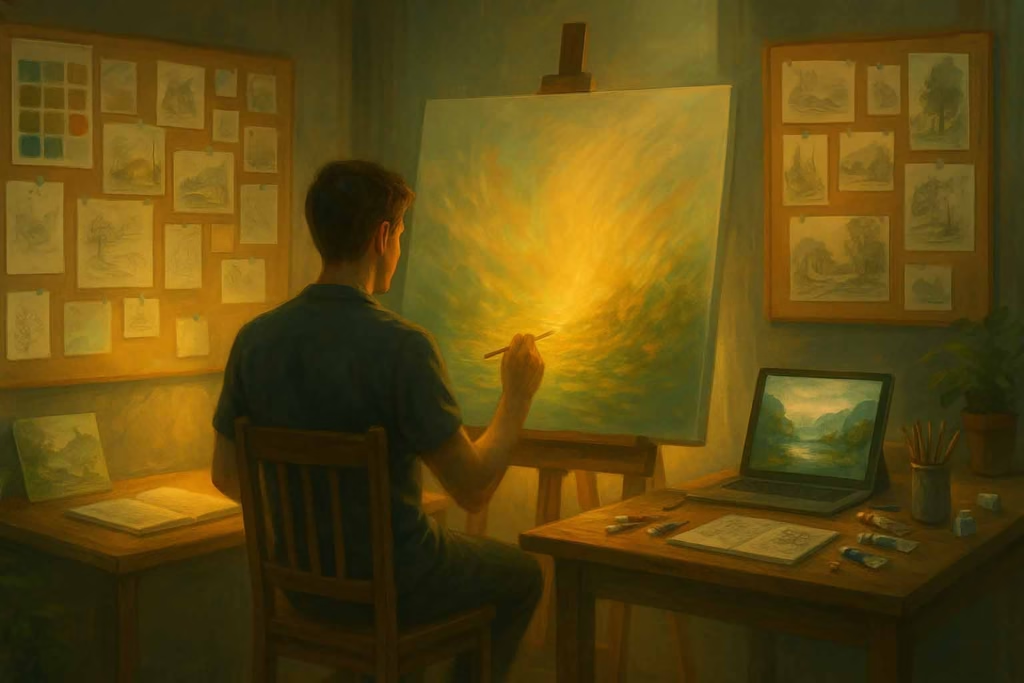
The goal isn’t to use all 18 methods constantly – it’s to become a painter who has a reliable toolkit of inspiration techniques and never runs out of meaningful subjects, compelling color relationships, and authentic creative direction. Your unique painter’s eye develops through the combination of systematic inspiration gathering and consistent practice translating that inspiration onto canvas.
Learning how to find inspiration for your art is a skill that develops over time. Start by experimenting with 2-3 methods from different categories this week. Notice which techniques feel most natural to your painting process and build your personal system around those methods. Your most authentic paintings emerge when your inspiration system aligns with your natural creative instincts and painting goals.
With these 18 science-backed methods organized into 5 clear categories, you now have a comprehensive toolkit for how to find inspiration for your art:
Environmental Methods (1-3): Nature, urban exploration, galleries
Digital Methods (4-7): Pinterest, Instagram, AI tools, virtual museums
Cross-Pollination (8-11): Photography, literature, film, fashion
Internal Reflection (12-15): Memory, dreams, emotions, journaling
Community Methods (16-18): Plein air groups, challenges, mentorship
Your blank canvas is no longer your enemy – it’s a space of infinite possibility, waiting for the perfect combination of preparation and inspiration that you now know how to reliably access using any of these 18 proven techniques. Choose your favorites, build your system, and maintain a consistent, fulfilling painting practice that never lacks for creative direction.

